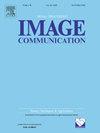Reducing the complexity of distributed video coding by improving the image enhancement post processing
IF 2.7
3区 工程技术
Q2 ENGINEERING, ELECTRICAL & ELECTRONIC
引用次数: 0
Abstract
The main attractive feature of distributed video coding (DVC) is its use of low-complexity encoders, which are required by low-resource networked applications. Unfortunately, the performance of the currently proposed DVC systems is not yet convincing, and further improvements in the rate, distortion, and complexity tradeoff of DVC are necessary to make it more attractive for use in practical applications. This requires finding new ways to exploit side information in reducing the transmitted rate and improving the quality of the decoded frames. This paper proposes improving DVC by exploiting image enhancement post-processing at the decoder. In this way, we can either improve the quality of the decoded frames for a given rate or reduce the number of transmitted bits for the same quality and hence reduce the complexity of the encoder. To do this, we used a conditional generative adversarial network (cGAN) to restore more of the details discarded by quantization, with the help of side information. We also evaluated numerous existing deep learning-based enhancement methods for DVC and compared them to our proposed model. The results show a reduction in the number of DVC coding operations by 46 % and an improvement in rate-distortion performance and subjective visual quality. Furthermore, despite reducing its complexity, our DVC codec outperformed the DISCOVER codec with an average Bjøntegaard PSNR of 0.925 dB.
通过改进图像增强后处理,降低分布式视频编码的复杂度
分布式视频编码(DVC)最吸引人的特点是它使用了低复杂度的编码器,这是低资源网络应用所需要的。不幸的是,目前提出的DVC系统的性能还不令人信服,并且需要进一步改进DVC的速率、失真和复杂性权衡,使其在实际应用中更具吸引力。这就需要寻找新的方法来利用边信息来降低传输速率和提高解码帧的质量。本文提出利用解码器的图像增强后处理来改进DVC。这样,我们既可以提高给定速率下解码帧的质量,也可以减少相同质量下传输的比特数,从而降低编码器的复杂性。为了做到这一点,我们使用条件生成对抗网络(cGAN)在侧信息的帮助下恢复更多被量化丢弃的细节。我们还评估了许多现有的基于深度学习的DVC增强方法,并将它们与我们提出的模型进行了比较。结果表明,DVC编码操作的次数减少了46%,并改善了率失真性能和主观视觉质量。此外,尽管降低了其复杂性,但我们的DVC编解码器的平均Bjøntegaard PSNR为0.925 dB,优于DISCOVER编解码器。
本文章由计算机程序翻译,如有差异,请以英文原文为准。
求助全文
约1分钟内获得全文
求助全文
来源期刊

Signal Processing-Image Communication
工程技术-工程:电子与电气
CiteScore
8.40
自引率
2.90%
发文量
138
审稿时长
5.2 months
期刊介绍:
Signal Processing: Image Communication is an international journal for the development of the theory and practice of image communication. Its primary objectives are the following:
To present a forum for the advancement of theory and practice of image communication.
To stimulate cross-fertilization between areas similar in nature which have traditionally been separated, for example, various aspects of visual communications and information systems.
To contribute to a rapid information exchange between the industrial and academic environments.
The editorial policy and the technical content of the journal are the responsibility of the Editor-in-Chief, the Area Editors and the Advisory Editors. The Journal is self-supporting from subscription income and contains a minimum amount of advertisements. Advertisements are subject to the prior approval of the Editor-in-Chief. The journal welcomes contributions from every country in the world.
Signal Processing: Image Communication publishes articles relating to aspects of the design, implementation and use of image communication systems. The journal features original research work, tutorial and review articles, and accounts of practical developments.
Subjects of interest include image/video coding, 3D video representations and compression, 3D graphics and animation compression, HDTV and 3DTV systems, video adaptation, video over IP, peer-to-peer video networking, interactive visual communication, multi-user video conferencing, wireless video broadcasting and communication, visual surveillance, 2D and 3D image/video quality measures, pre/post processing, video restoration and super-resolution, multi-camera video analysis, motion analysis, content-based image/video indexing and retrieval, face and gesture processing, video synthesis, 2D and 3D image/video acquisition and display technologies, architectures for image/video processing and communication.
 求助内容:
求助内容: 应助结果提醒方式:
应助结果提醒方式:


